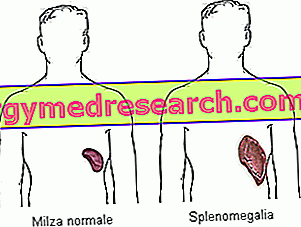Generality
Splenomegaly is the best known clinical sign as an enlarged spleen .

The presence of splenomegaly can be asymptomatic or responsible for a symptomatic picture that includes: pain and sense of fullness in the upper left region of the abdomen, sense of satiety after a light meal or even without eating, anemia, nausea, vomiting, fatigue and ease to bleeding.
The complications of an enlarged spleen range from the possible rupture of the spleen, following a trauma, to the marked tendency to contract infectious diseases.
For a correct diagnosis of splenomegaly, in many cases, the simple palpation of the spleen is sufficient; however, it is a must always carry out diagnostic tests, to understand the causes that have caused the enlargement of the organ in question.
Most often, the treatment of splenomegaly is based on the treatment of the causal factor; infrequently, splenomegaly is a problem that can only be solved by removing the spleen.

Brief anatomical reference of the spleen
The spleen is an organ of the abdomen, the size of a fist and located to the left, just below the rib cage.
The spleen covers different functions:
- It fights infections, controlling the presence of circulating pathogens (bacteria and foreign particles) and producing antibodies and white blood cells.
- Promotes the maturation of red blood cells (or erythrocytes ).
- Cleans blood from red blood cells, white blood cells and aged or abnormal platelets.
- It plays the role of iron reserve, platelets and white blood cells.
What is splenomegaly?
Splenomegaly is the enlarged spleen ; it is therefore a medical condition characterized by the enlargement of the spleen beyond the limits of its normal dimensions.
Since the enlarged spleen is usually the result of a morbid condition, the term splenomegaly can also define a " pathological increase in the volume of the spleen ".

Causes
The spleen is an organ that, due to its numerous fields of action, can be indirectly involved in a very long series of diseases (eg infections, metabolic diseases, circulatory diseases, endocrine diseases, tumors, etc.).
The enlarged spleen is a reflection of the aforementioned participation: in fact, it is a very common clinical manifestation on the occasion of various morbid states, both acute and chronic.
The causes of splenomegaly include:
- Viral infections, such as mononucleosis (it is the main causal factor of an enlarged spleen in young people in industrialized countries); bacterial infections, such as syphilis and bacterial endocarditis ; finally, parasitic infections such as malaria and leishmaniasis (they are particularly common in developing countries).
During infectious processes, the spleen becomes enlarged due to the hypertrophy of the reticulo-endothelial and lymphatic structures involved in the immune processes.
- Portal hypertension, due to liver disease, such as cirrhosis, or to thrombosis of the splanchnic vein or portal vein . In such situations, it is more appropriate to speak of congestive splenomegaly, since the increase in volume of the spleen derives from the increase in blood contained in it.
- Various types of hemolytic anemia, a condition - the latter - characterized by the premature destruction of red blood cells. The most common type of hemolytic anemia, involved in the appearance of an enlarged spleen, is thalassemia .
In these circumstances, the enlargement of the spleen results from an overload of haemocateretic work, activity through which the spleen removes the abnormal red blood cells (NB: haemocateresis or haemocateretic work is the process of purification of blood from aged or abnormal blood cells).
- Blood neoplasms, such as leukemias or lymphomas (eg, Hodgkin's disease). The size of the spleen increases due to the presence, next to the healthy splenic tissue, of a pathological neoplastic tissue (NB: the splenic tissue is the tissue of the spleen).
- Some metabolic diseases, such as sarcoidosis, amyloidosis, thesaurismosis, Gaucher disease and Niemann-Pick disease . The size of the spleen increases due to the presence, next to the healthy splenic tissue, of a tissue of other nature (but not neoplastic).
Risk factors
Anyone can develop splenomegaly. However, some categories of people are more at risk than others; the categories of people most at risk of an enlarged spleen include:
- Children and young adults suffering from an infectious disease, such as mononucleosis;
- People with Gaucher disease, Niemann-Pick disease or metabolic diseases that specifically affect the liver or spleen;
- Individuals living or attending, for work reasons, countries where malaria is endemic.
Symptoms and complications
See also: Splenomegaly: Causes and Symptoms
Splenomegaly is a clinical sign ; therefore it is not really a pathology, but the expression of a pathology.
Very often, patients with an enlarged spleen do not show any symptoms (enlarged asymptomatic spleen); more rarely, especially when splenomegaly is important or the spleen has swollen rapidly, they may complain of symptoms such as:
- Pain or sense of fullness in the upper left region of the abdomen. Sometimes, the pain can spread to the left shoulder;
- Sense of satiety without eating;
- Rapid onset of satiety during a meal, even very small, due to the compressive effect on the stomach by the enlarged spleen;
- Nausea and vomit;
- Anemia;
- Fatigue;
- Ease of bleeding, even after minimal trauma. The appearance of hemorrhages is purple and petechiae;
- Ease to infections. People with an enlarged spleen show a marked tendency to develop infectious diseases.
Effects of an enlarged spleen
An enlarged spleen affects each of the organ's functions, listed at the beginning of the article.
For example, in the presence of splenomegaly, the spleen begins to filter and seize large quantities of red blood cells, reducing the number of the latter in the blood, sometimes even dangerously; the same thing happens for platelets and white blood cells.
Excessive seizure of red blood cells, red blood cells and platelets can obstruct the spleen and interfere with the other functions of the latter. Moreover, again due to the seizure, the organ in question can grow to the point of making the blood supply of the vessels supplying it insufficient, with ischemic suffering of more or less extensive portions of the spleen.
The massive seizure of blood cells by the enlarged spleen is one of the effects of a condition often associated with splenomegaly known as hypersplenism .
In the medical field, the term hypersplenism indicates an abnormal functioning of the spleen, such that the latter becomes hyperactive and overproductive, with harmful effects for the human organism.
Complications
Complications can result from failure to treat splenomegaly. Among the potential complications of the enlarged spleen, they certainly deserve a quote:
- The consolidation of the ease of infection, anemic processes and the tendency to bleed . What is stated in the previous sub-chapter explains why: the causal factors, in fact, are the seizure by the spleen of red blood cells, platelets and white blood cells, and the consequent impoverishment of these cells just mentioned in the blood.
In medicine, the reduction of blood cells (due to the spleen, in the specific case of splenomegaly) is called pancytopenia .
- Spleen rupture . It is a phenomenon closely related to the increase in the size of the organ: the larger the spleen, the more susceptible to breakages of traumatic origin.
Diagnosis
The diagnosis of splenomegaly is quite simple. Very often, in fact, doctors are able to identify an enlargement of the spleen by palpating the area in which it resides (NB: anatomical palpation is typically part of the objective examination ).
Confirmation exams
Although palpation of the spleen during the physical examination provides more than reliable information, the diagnostic confirmation of the presence of splenomegaly requires other tests, which are specifically:
- Radiography and / or ultrasound imaging techniques. They account very clearly for the extent of splenomegaly.
Moreover, they are useful when the spleen is not palpable, but there are all the conditions to believe in the presence of an enlarged spleen.
- Blood tests, aimed at assessing the levels of platelets, white blood cells and erythrocytes.
As previously stated, in people with splenomegaly blood levels of blood cells tend to be lower than normal because they are seized in the spleen.
Ultrasound examination: when we talk about an enlarged spleen? When is splenomegaly mild and when is it moderate?
Based on the ultrasound images, the doctors formulate the diagnosis of splenomegaly in the presence of a spleen over 11 centimeters in longitudinal diameter, 7 centimeters in transverse diameter and 4 centimeters in thickness.
To determine the severity of a splenomegaly, we rely on the longitudinal diameter :
- when the longitudinal diameter is between 11 and 20 centimeters in size, splenomegaly is mild or moderate ;
- when instead the longitudinal diameter exceeds 20 centimeters, the enlarged spleen is severe .
Research the causes of splenomegaly
Of course, after having diagnosed a splenomegaly it is necessary to go back to the causes that caused the enlargement of the spleen, since it is starting from the triggers that the doctors are able to plan the most adequate therapy.
The identification of the precise causes of a splenomegaly may require a test for liver function, antibody tests, the study of the morphology of white blood cells and red blood cells and, sometimes, a bone marrow biopsy.
Spleen biopsy is very rare due to the high risk of massive blood loss from the organ.
Diagnosis of asymptomatic cases
The diagnosis of asymptomatic cases of splenomegaly is very often random and takes place during a physical examination of the abdomen or an abdominal ultrasound, both performed for other reasons.
Therapy
See also: Drugs for the treatment of splenomegaly
As a rule, the treatment of splenomegaly is subject to the treatment of the underlying disease, ie the morbid condition that caused the enlargement of the spleen.
This explains why, during the diagnosis of an enlarged spleen, it is essential to delineate precisely the triggers.
The form of treatment which, in order to resolve a morbid condition, focuses on treating the causative factors is called causal therapy .
How should the patient behave during causal therapy?
For those who are following a causal treatment for splenomegaly, doctors recommend avoiding any activity and sport, during which there is a certain risk of spleen trauma.
As readers will remember, in fact, the traumas at the spleen, in an individual with an enlarged spleen, have a high probability of causing this organ to rupture.
Surgical treatment
In at least two unfortunate circumstances, which are:
- Severe enlargement of the spleen, associated with complications (high risk of infection and / or rupture of the spleen)
- Inability to implement effective causal therapy,
splenomegaly requires the intervention of the surgeon and the implementation of an operation to remove the spleen, whose specific name is splenectomy .
It should be noted that, today, surgeons choose to practice splenectomy with less lightness than in the past: in fact, although the spleen is not a vital organ, its removal raises the risk of contracting infections, some of which are also very serious.
HOW TO REDUCE THE POST-SURGICAL INFECTION RISK
To contain the aforementioned risk of post-surgical infection, patients for whom splenectomy is scheduled should undergo vaccines against Haemophilus influenzae, Streptococcus pneumoniae, meningococcus and influenza virus (in this case a new vaccination is needed every year).
Furthermore, in some particular situations, doctors could also prescribe long-term antibiotic prophylaxis .
Some useful tips for people undergoing splenectomy:
- Undergo periodic blood checks;
- Contact your doctor at the first signs of an infection;
- Avoid travel to areas of the world where certain infectious diseases are endemic.
IS THERE AN ALTERNATIVE TO SURGERY?
An alternative to splenectomy is the reduction of the enlarged spleen, through the administration of high-energy radiation, such as ionizing radiation .
This kind of treatment is a practice that doctors typically consider in the case of chronic lymphatic leukemia associated (obviously) with splenomegaly, with the intent to kill cancer cells.
Prognosis
The prognosis in case of splenomegaly depends to a large extent on the treatability of the triggering cause : if a causal factor is successfully curable, the enlarged spleen is also; if instead a triggering factor is particularly difficult to treat, splenomegaly could be an unsolvable problem and, for this reason, request the intervention of the surgeon.
Having said that, in most cases, splenomegaly is a reversible condition satisfactorily and without excessive difficulty, as it almost always depends on treatable causes.
Prevention
To prevent the phenomenon of splenomegaly, it is essential to implement every preventive measure against the triggering factors. As an example of what has just been stated:
- To prevent forms of splenomegaly of infectious origin, it is essential to avoid any possible source of infection (eg avoiding contact with infected people, traveling to places where a disease such as malaria is endemic, etc.);
- To prevent splenomegaly due to cirrhosis (liver disease), it is essential not to abuse alcohol.



